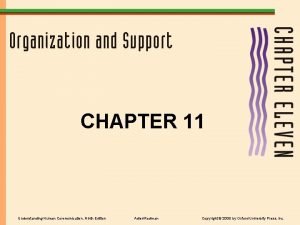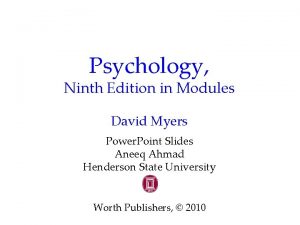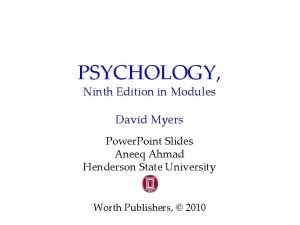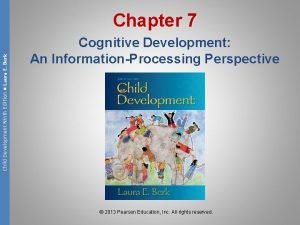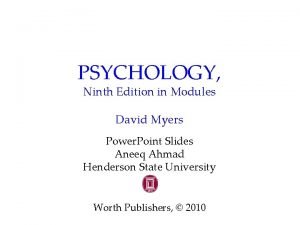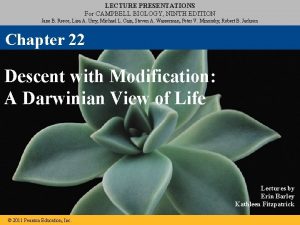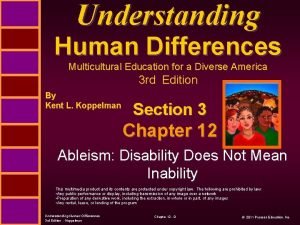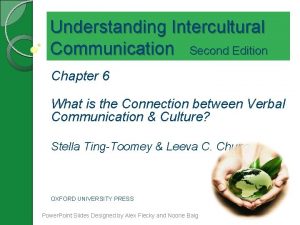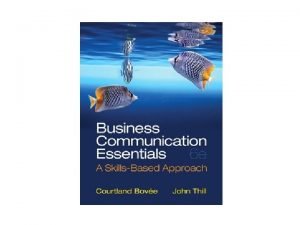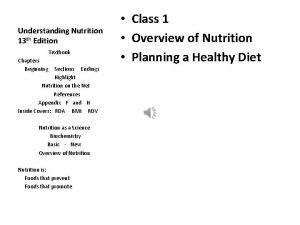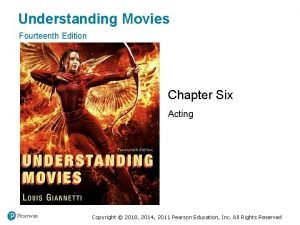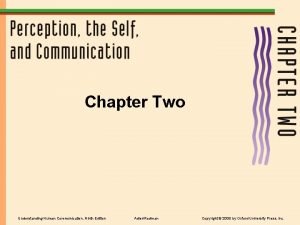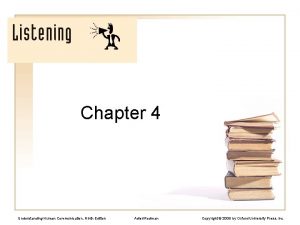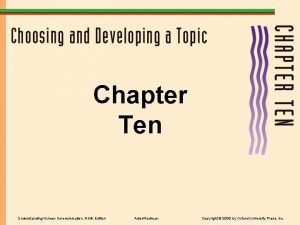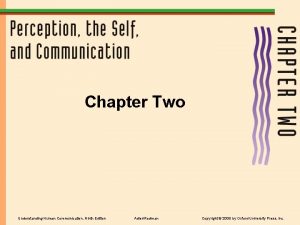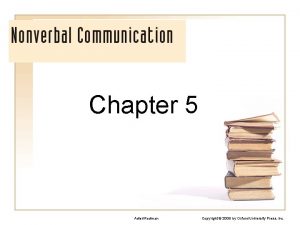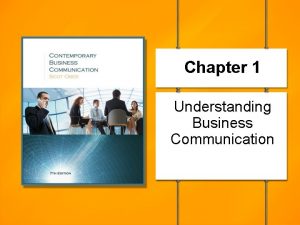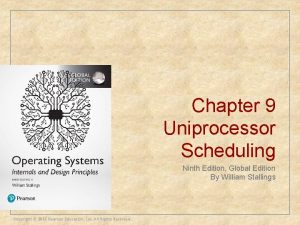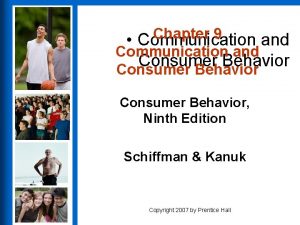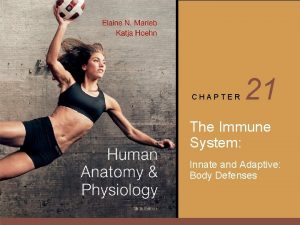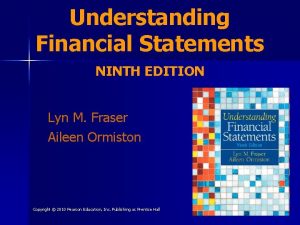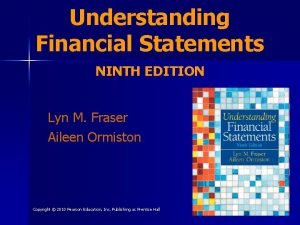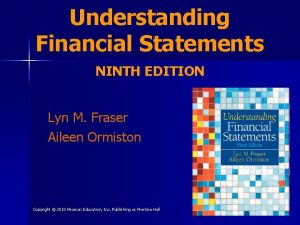CHAPTER 11 Understanding Human Communication Ninth Edition AdlerRodman









![• Formal outline: [For this course] • Typed • Complete sentences • Two • Formal outline: [For this course] • Typed • Complete sentences • Two](https://slidetodoc.com/presentation_image_h/99b9b42898163f3ae0460789f5301a56/image-10.jpg)











- Slides: 21

CHAPTER 11 Understanding Human Communication, Ninth Edition Adler/Rodman Copyright © 2006 by Oxford University Press, Inc.

Tools designed to make structuring your speech easier and more effective. • Working outlines • Formal outlines • Speaking notes Understanding Human Communication, Ninth Edition Adler/Rodman Copyright © 2006 by Oxford University Press, Inc.

Simple principles to build an effective outline. • Standard symbols • Standard format • The rule of division • The rule of parallel wording Understanding Human Communication, Ninth Edition Adler/Rodman Copyright © 2006 by Oxford University Press, Inc.

Other principles include: • Organizing your points in a logical order • Using transitions • Introductions • Conclusions Understanding Human Communication, Ninth Edition Adler/Rodman Copyright © 2006 by Oxford University Press, Inc.

Effective use of supporting material. • Functions of supporting material • Types of supporting material • Style of support, including narration and citation Understanding Human Communication, Ninth Edition Adler/Rodman Copyright © 2006 by Oxford University Press, Inc.

Visual aids are a unique type of supporting material. • Types of visual aids • Media for the presentation of visual aids • Rules for using visual aids Understanding Human Communication, Ninth Edition Adler/Rodman Copyright © 2006 by Oxford University Press, Inc.

Good Speech Structure • Use your purpose and thesis statement • Introduction: Build relationship • Attention-getter • Preview: Tell them what you’re going to tell them • 3 -5 main points • Conclusion • Review: Tell them what you’ve told them • Final remarks Understanding Human Communication, Ninth Edition Adler/Rodman Copyright © 2006 by Oxford University Press, Inc.

Techniques • Pose a question early on • They’ll realize they need to listen intently • OK to use humor --- don't get off track • Let your personality show. • Illustrate a point telling a short personal story. Understanding Human Communication, Ninth Edition Adler/Rodman Copyright © 2006 by Oxford University Press, Inc.

Preparing • Working outline: • Rough form • Formal outline Understanding Human Communication, Ninth Edition Adler/Rodman Copyright © 2006 by Oxford University Press, Inc.
![Formal outline For this course Typed Complete sentences Two • Formal outline: [For this course] • Typed • Complete sentences • Two](https://slidetodoc.com/presentation_image_h/99b9b42898163f3ae0460789f5301a56/image-10.jpg)
• Formal outline: [For this course] • Typed • Complete sentences • Two pages • Written in active voice; like you will deliver in your speech • Cite outline sources • Use MLA or APA style (Modern Language Assoc. of America, or American Psychological Association) • Min of 3 sources published within the last three months Understanding Human Communication, Ninth Edition Adler/Rodman Copyright © 2006 by Oxford University Press, Inc.

Speech Outline: • Traditional outline format • Rule of division • Each main point is divided into at least two points • Rule of Parallel Wording • Main points, worded in similar, “parallel” way • Main points should have only one idea Understanding Human Communication, Ninth Edition Adler/Rodman Copyright © 2006 by Oxford University Press, Inc.

Organize in a Logical Order • Time • Space • Topic • Problem-solving • Cause-Effect • Motivated Understanding Human Communication, Ninth Edition Adler/Rodman Copyright © 2006 by Oxford University Press, Inc.

Capturing the Attention • Use a quote • Tell a story • Tell a relevant joke • SET A MOOD Understanding Human Communication, Ninth Edition Adler/Rodman Copyright © 2006 by Oxford University Press, Inc.

Transitions • Use your purpose and thesis statement Understanding Human Communication, Ninth Edition Adler/Rodman Copyright © 2006 by Oxford University Press, Inc.

Tips for Great Presentations • • Prepare. Have passion and sincerity. Be relevant. Build relationship with listeners. Engage. Vary your delivery. Tell “stories” Be interesting and conversational. Don’t “read” a script. (OK to use notes) Understanding Human Communication, Ninth Edition Adler/Rodman Copyright © 2006 by Oxford University Press, Inc.

Great Presentations • 3 P’s: • Prepare • Practice • Perform • Content • Outcome you want? • Be clear Understanding Human Communication, Ninth Edition Adler/Rodman Copyright © 2006 by Oxford University Press, Inc.

Taboos • Forgetting to turn off your screen saver. • Speaking too quickly. • Using too many bullets and fonts. • abcdefghijklmn� √ • Placing too many words on a slide. • Wasting their time. Understanding Human Communication, Ninth Edition Adler/Rodman Copyright © 2006 by Oxford University Press, Inc.

Be Confident • I know who you are & why you came. • I am well organized. • I will be interesting and conversational. • I know my subject. • Here are my most important points. • I am finished. Understanding Human Communication, Ninth Edition Adler/Rodman Copyright © 2006 by Oxford University Press, Inc.

• Learn how to use video and Power. Point effectively. • Learn how to identify and tell strategic and relevant stories. Understanding Human Communication, Ninth Edition Adler/Rodman Copyright © 2006 by Oxford University Press, Inc.

Making Points • Make a point – an impression. • Shakespeare: “All the world is a stage. ” • Conversational voice, not lecture tone. • Active listening. • Avoid gender, stereotype references • End with Impact. Understanding Human Communication, Ninth Edition Adler/Rodman Copyright © 2006 by Oxford University Press, Inc.

NEXT MONDAY 11/28 Chapters 12 -13 -14 ** Possible Guest Speeches Start 11/30 12/5 12/7 HAVE A HAPPY THANKSGIVING! Understanding Human Communication, Ninth Edition Adler/Rodman Copyright © 2006 by Oxford University Press, Inc.
 Adler and rodman 2006
Adler and rodman 2006 Adler and rodman 2006
Adler and rodman 2006 Levels of analysis psychology
Levels of analysis psychology Mankiw macroeconomics 9th edition
Mankiw macroeconomics 9th edition Human anatomy & physiology edition 9
Human anatomy & physiology edition 9 Psychology ninth edition david g myers
Psychology ninth edition david g myers Social psychology ninth edition
Social psychology ninth edition Biology ninth edition
Biology ninth edition Child development ninth edition
Child development ninth edition Berk 2013 child development
Berk 2013 child development Lysanx
Lysanx Psychology ninth edition in modules
Psychology ninth edition in modules David myers psychology 9th edition
David myers psychology 9th edition Biology ninth edition
Biology ninth edition Campbell ninth edition
Campbell ninth edition Understanding human differences 5th edition
Understanding human differences 5th edition Understanding intercultural communication 2nd edition
Understanding intercultural communication 2nd edition Business essentials 12th edition answer key
Business essentials 12th edition answer key Chapter 1 understanding business communication
Chapter 1 understanding business communication Understanding nutrition 13th edition rental
Understanding nutrition 13th edition rental Copyright
Copyright Understanding earth 7th edition
Understanding earth 7th edition

